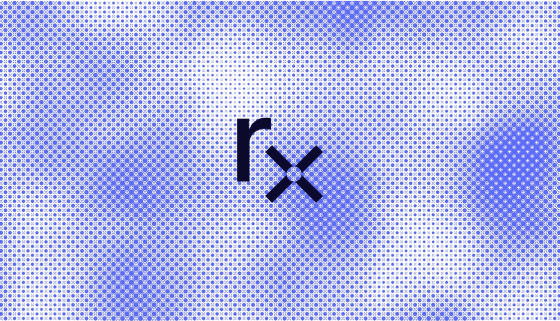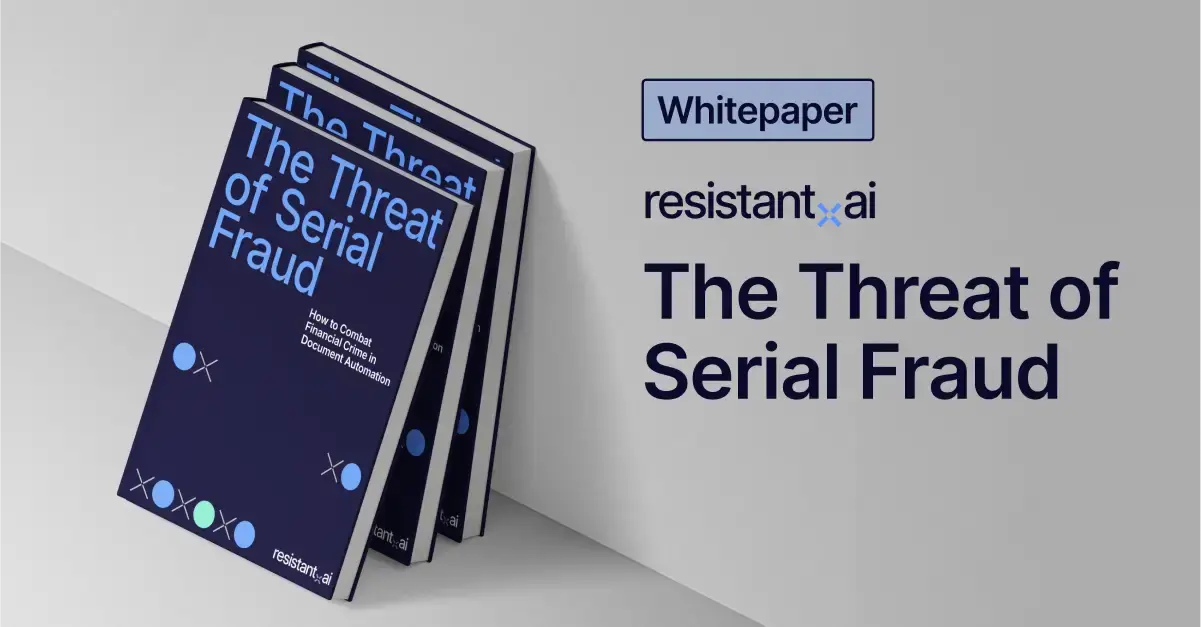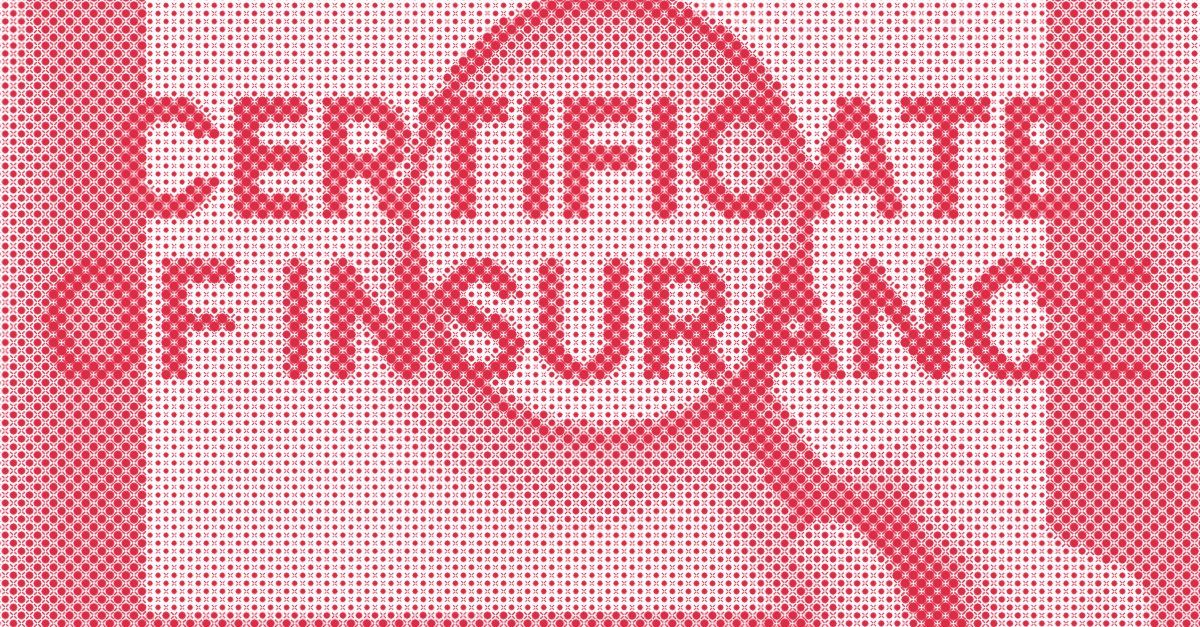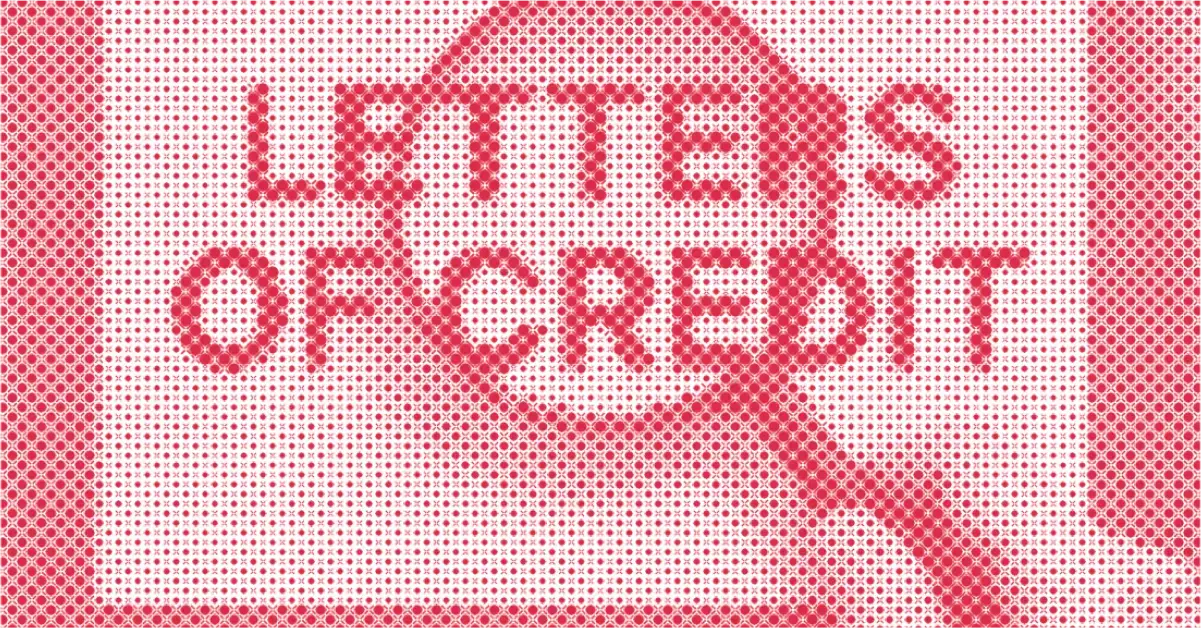ChatGPT image generation increases document fraud across industries



Artificial Intelligence has transformed industries, powering everything from personalized recommendations to advanced fraud detection solutions.
However, alongside beneficial applications, generative AI is increasingly used for "fraud gpt," posing significant threats by making document fraud more sophisticated and accessible than ever before.
As Jan Syrenik, Head of Product at Resistant AI, stated in our ThreatGPT webinar (watch the full recording):
This level of accessibility is rapidly becoming a critical challenge, especially for sectors such as online marketplaces, payment platforms, insurance, banking, and lending as they deal with higher volumes of AI-generated submissions.
In this blog, we’ll discuss the rising threat of AI document generators (like ChatGPT), how we got here, the roots of the problem, and what your business can do to fight it.
Table of contents
What is AI-generated document fraud?
AI-generated document fraud refers to document fraud committed via generative AI technologies (such as GPT-powered large language models (LLMs) and diffusion models), specifically for creating fake official documents to mislead businesses and institutions alike.
Generative AI’s increasingly advanced capability to produce authentic-looking documents has opened the doors of fraud for malicious actors who might not have previously had the access or the wherewithal to attempt these crimes.
Fraud GPT tools can fabricate realistic-looking insurance claims, bank statements, identification papers, and other sensitive documents with minimal effort or expertise required from the user.
Unlike traditional methods of document fraud, which typically involve altering existing documents, GPT doc fraud allows fraudsters to create entirely synthetic documents with a few simple key strokes.
Many businesses are already beginning to come across these documents:

Results from our “ThreatGPT” webinar which polled hundreds of fraud professionals from industries like tenant screening, insurance, investment and finance, lenders, banking and more.
Why is AI-generated document fraud on the rise?
The primary driver behind the surge in AI-generated document fraud is the unprecedented accessibility of generative AI tools.
Historically, document fraud required significant skill, time, and resources. Fraudsters needed advanced editing software and the expertise to hide their work from detectors.
Today, user-friendly platforms powered by generative AI have improved their text-based image generation, democratizing their fraud capability and enabling virtually anyone (even those without technical expertise or the drive to commit crime) to generate realistic fraudulent documents within minutes.
If we consider the fraud triangle, this isn’t hard to believe. The triangle mandates an equal push from pressure (financial or emotional forces), rationalization (moral justification), and opportunity (ability to execute the plan).
Gen AI provides that missing bump in the opportunity vertical, driving many on-the-fence fraudsters towards a life of crime.
Platforms that provide generative AI functionalities are widely available, often for free or at minimal cost, allowing access to a broader audience. ChatGPT alone has more than 400 million users, not to mention Gemini (350M users) and Meta AI (600M users).

Even if 0.1% of them try to experiment with fraud, you’re looking at millions of potentially fraudulent AI documents to evaluate.
Sure, many tools have safeguards in place that protect against blatantly obvious prompts such as “give me a fake bank statement template.” However, it’s impractical (if not impossible) for these companies to have safeguards for every potential misuse of such versatile technologies.
Safeguards tend to rely on the AI itself recognizing it is doing something illegal or sketchy. And as we’ve said before, LLMs are essentially quite naive and trained to be helpful by default, so workarounds for these minimal barriers aren’t hard to come up with. In some cases, simply removing the word “fake” is enough to bypass them.
As a result, marketplaces, payment firms, banks, lenders and insurers now face an escalating volume and complexity of fraudulent activity, necessitating rapid innovation in fraud detection and risk management solutions.
How is AI-generated fraud impacting businesses?
AI-generated fraud is here. The impact of these changes will depend on what kind of business you are. Do you experience more first or third party fraud?
The first-party threat
Industries that provide loans, claims, tenant screening, expense accounting, or other activities with high exposure to consumers may have to deal with an uptick in first-party fraud: fraud committed by individuals using their own identities. These Gen AI tools are highly accessible, providing an opportunity that will be hard to ignore for the financially desperate.

Despite being amateurs, these would-be fraudsters pose a particular challenge in detection. Unlike organized crime rings, these are real people. Their attempts will look genuine with no behavioral or contextual signals to give them away and their AI generated documents will look like normal, green-lit document submissions. Unless they decide to repeat their crime, this may be their first and only attempt, giving your fraud team nothing to work with.
Fortunately, the amateur nature of these attempts also has drawbacks. 80% of attempts will still be caught by checking the documents themselves with standard metadata checks to see if they were generated by, say, OpenAI.
However, changing a png to a .jpeg isn’t that challenging, and doing so removes most metadata details. The real problem lies in the remaining 20%, who will think to do so. The metadata won’t be there to save you, and all of their other behaviors will seem normal.
There won’t be any other signals to rely on to build context around their fraud — a “zero-day fraud”, if you will. The only solutions will be to invest in tools that can assess the document’s authenticity directly without relying on context.
The third party threat
Loans, claims, banks, and payment providers may have to deal with more third-party or serial fraudsters (individuals who commit fraud behind an alias or an organization).

AI image generation expands the options around serial fraud, allowing criminals to generate a series of different backgrounds instantly or add physical elements like stains, wrinkles, rips, and shadows en masse to their submissions.

To be clear, serial fraudsters aren’t relying solely on GPT to produce their fakes. Often, their fraud attempts will be much higher quality because they’re based on legitimate templates they’ve downloaded illegally.
In these cases, contextual analysis will take on even more importance. Contextual signals like geographic data, user behavior, and device data will still reveal tell-tale signs of fraud.
You may just have to improve or update these capabilities to accommodate new AI document fraud tactics, including adding a layer that verifies the document’s authenticity directly.
Learn more about how AI can add context to document submissions in this clip from the ThreatGPT webinar:
GPT watermark limitations
If you think Generative AI watermarks will save you, think again. These also have their limitations. Namely, watermarks like those created by ChatGPT can only be detected by submitting documents, private information and all, to their API for verification.
As businesses struggle towards stopping these AI generated fakes, having to submit these documents to third parties might conflict with their own unnegotiable compliance requirements, forcing them to either sacrifice their systemic safety from fraud or legal responsibility.
But just how good are these FraudGPT fake documents?
Are AI document generators a quality or quantity problem?
Improvements are happening incredibly quickly and the contrast, even after just a year is incredibly stark:

In just one year, May 2024 -2025, you can see how these image generation capabilities have improved.
The document itself is impressively improved, going from a poor imitation of a 1920s newspaper to an almost exact looking falsification. However, the text is still not perfect and this illustrates their current limitations.
While current large language model (LLM) image generators can definitely create high-quality AI-generated forgeries, at this point they can either create their own idea of what a document is with perfect textual accuracy (but look nothing like the real thing) or create something that resembles a real document, but struggle to get text that doesn't devolve into gibberish.
Take a look at this example below:

When the LLMs are allowed to generate freely “i.e., make me a Wells Fargo bank statement,” it generates a child's idea of what a bank statement should look like — but with accurate and readable copy.
Once you restrict the generations to a standardized template, asking it to reproduce a real Wells Fargos statement, textual inconsistencies — gibberish, slurring, or smudging — increases.
While this may not seem like an issue, keep in mind the following:
-
Even if you can still pinpoint a poor layout or unlikely character with the naked eye, any automated workflow relying on OCR will likely be fooled into reading the content, since that technology is focused extracting content in the worst of circumstances, as opposed to visually classifying or authenticating the document.
-
Soon enough, the text issues will also be solved, and even the naked eye will fail to catch the inconsistencies.

Gen AI fraud is currently about 90% of the way to completely undistinguishable fakes.
For now, generated documents that try to adhere to existing templates often contain subtle imperfections (inconsistent formatting, typographical errors, unrealistic logos, or distorted text) that can betray their fraudulent nature:

For expert fraudsters, even these errors can be fixed with the best targeted editing in AI and pdf editors, and it won't be long before general model improvements make this easy enough for a wider audience.
Unfortunately for fraud checkers, the will no longer be able to rely on the usual smoking guns like similarities in cross-document verification across submissions, since AI-generated documents can create endless patterns and physical variation (folded creases, ripped edges, background elements, etc).
Even if perfection is not available yet, the real threat might not come from individually flawless documents but rather from an overwhelming volume of low-quality fraudulent submissions. Essentially a "death by a thousand papercuts" scenario.
Businesses face the daunting task of managing potentially millions of AI-generated documents, each individually simple to detect, but collectively overwhelming without automated verification systems in place — many of which are the very kinds of automated verification systems that can be easily fooled.
Investing in scalable, automated document verification software is more critical than ever. Companies need to be capable of handling massive volumes of submissions efficiently.
Despite that, many companies still rely on manual processes or outdated document processing solutions that don't take fraud into account.
Results from our “ThreatGPT” webinar which polled hundreds of fraud professionals from industries like tenant screening, insurance, investment and finance, lenders, banking and more.
Learn more about the evolution of text generation for GPT doc fraud in this clip from the ThreatGPT webinar:
What industries are most affected by AI document fraud?
The threat posed by generative AI document fraud affects just about all industries that depend heavily on trustworthy documentation. Here’s an overview on sectors that will see the most significant impact:
1. Marketplaces
With the amount of customer and merchant onboarding (KYB) they do, E-commerce and peer-to-peer platforms are increasingly exploited with fake documentation that misrepresents product authenticity, seller identity, or transaction history.
AI-generated invoices, certificates, and shipping records can be used to bypass verification processes, deceive buyers, or facilitate counterfeit operations.
Documents affected: Invoices, authenticity certificates, shipping labels, seller verification documents, business licenses.
2. Payment providers
Fintech platforms and traditional payment processors face rising fraud attempts using synthetic documents crafted to fool onboarding checks or enable refund scams. Fraudsters now submit AI-generated identity documents, transaction receipts, and address proofs to open accounts, trigger chargebacks, or launder funds.
One type of document whose simplicity and lack of standardized templates is particularly easy for AI to generate — and why they were so popular by Linkedin influencers peddling the end of document verification — are fake receipts, truly a nightmare for easy expense report providers.
Documents affected: ID documents, utility bills, payment confirmations, transaction receipts, bank statements.
3. Insurance
The issue of generative AI document forgery in insurance is becoming increasingly prevalent, capturing significant attention in professional communities like LinkedIn.
Whether dealing with purchase receipts, invoices, or repair bills, or AI-generated images of totaled vehicles, these synthetic images can be convincingly realistic, making it difficult for adjusters to differentiate legitimate claims from fraudulent ones without robust detection tools.
Documents affected: Receipts, claims documents, medical records, repair estimates, police reports, vehicle registration and ownership documents, photographic evidence.
Learn more about why receipts are a prime target for AI fake document generation in this clip from the ThreatGPT webinar:
4. Banking and financial services
Financial institutions face heightened risks due to easily generated financial documents that complicate credit evaluations and customer verifications.
Documents affected: Bank statements, pay stubs, investment records, tax returns.
5. Lending and credit providers
Lenders of consumer and high value/securitized loans must scrutinize AI-generated employment verification, credit, car financing, mortgage, trade and B2B finance documents which can lead to increased loan defaults and losses.
Documents affected: Employment verification letters, income statements, loan applications.
6. Real estate
Fraudulent documentation can disrupt property sales, rentals, and mortgage lending, complicating verification processes and increasing the risk of fraud.
Documents affected: Lease agreements, proof-of-income documents, property titles, appraisal reports.
7. Healthcare
Healthcare providers and insurers face potential fraudulent claims involving fabricated medical bills and treatment documentation, leading to financial losses and compliance issues.
Documents affected: Medical bills, prescriptions, treatment records, medical certificates.
8. Government and public services
Public institutions are vulnerable to falsified identification and qualification documents, undermining trust and complicating citizen verification processes.
Documents affected: Passports, driver’s licenses, identity cards, birth certificates, academic transcripts.
How can you defend your business against fraud GPT?
Protecting your business from Fraud GPT involves implementing a structured combination of internal practices, policies, and technological solutions. Here’s a practical list of steps and advice to defend against AI-generated document fraud:
Check the basics to fight the basics
More fraudsters means less sophistication to some extent. Clumsy fraudsters won’t know how to (or won’t think to) hide metadata changes, adjust file format, or copy official layouts. By knowing your documents, what they’re supposed to look like, and setting clear acceptance policies, you can stop 80% of these attempts.
Recognize the AI world
While basics can stop basics, the tech has gotten better to the point where they won’t stop everyone. For experienced fraudsters, metadata won’t save you, formats are fungible, layouts change, memory is fallible, and content generation is nearly solved.
Take a layered approach
Your best defense is implementing fraud prevention at every stage of the document journey, layering defenses to help cover up weak spots left by previous layers. Relying on data from the whole journey can help stop organized groups while an AI fraud detector can help with direct document analysis.
Monitor and track fraud trends
This is not the first fraud trend to emerge, nor is it the last. Stay proactive by tracking fraud patterns within your industry and universally, allowing you to anticipate threats, put proactive defenses in place, and respond quickly when problems occur.
Conduct frequent audits
Regularly audit your document verification procedures to identify weaknesses and continuously refine your detection methods.
The solution: AI-automated document fraud detection
The escalating threat posed by generative AI necessitates advanced, proactive defenses beyond traditional methods. You need good AI to fight the bad AI.
AI-automated document fraud detection is specifically designed to meet this challenge, providing an essential layer of security that can effectively identify, flag, and manage AI-generated fraudulent documents.
AI-powered solutions don’t just address individual instances of fraud, they systematically analyze document characteristics, metadata, and behavioral anomalies, ensuring your organization can reliably differentiate genuine documents from synthetic ones at scale.
The best part? Some AI-powered solutions (like our fraud checker at Resistant AI) don’t rely on metadata or watermarks to detect GPT fakes. You can detect GPT without reading the document and jeopardizing your customer data or compliance requirements.
Beyond their ability to detect AI generated fraud, AI-powered fraud detection solutions benefit businesses with:
-
Scalability. Automatically analyze thousands or millions of documents.
-
Accuracy and efficiency. Drastically reduce manual verification workloads while improving detection accuracy and consistency.
-
Explainability. Clearly document the reasons behind fraud decisions, which is essential for compliance and regulatory audits.
-
Adaptability. Continuously adapt to evolving fraud tactics through self-learning algorithms.
-
Real-time detection. Immediately flag fraudulent documents upon submission, allowing swift preventive action.
-
Customization. Adaptive decisioning means you get verdicts that work for your risk appetite.
-
Layered defense. Leverage data beyond the document (such as behaviors, identity, and transactional signals) as part of your verdict, then use these inputs to build a “layered” defense. Improve your own processes while implementing a diverse tool like ours to provide fraud checks at every step on the document’s journey.
Conclusion
Here at Resistant AI, we specialize in AI fraud detection. We proactively identify synthetic, AI-generated documents by recognizing subtle visual textures and structural anomalies unique to generative AI techniques.
We understand that generative AI isn't a new phenomenon. It’s an evolving one. Our latest ensemble of AI document generator detectors effectively pinpoints documents exhibiting telltale signs of recent generative techniques, maintaining an exceptional accuracy rate with a false-positive (FP) rate under 1%.
This ensures your business remains secure without compromising operational efficiency or customer trust. Want to see it in action?
Scroll down to book a demo.
Frequently asked questions (FAQ)
Hungry for more AI-generated document content? Here are some of the most frequently asked questions about fraud GPT from around the web.
What exactly is AI-generated document fraud?
AI-generated document fraud refers to the use of generative AI (such as GPT-based language models) to produce synthetic documents such as fake insurance claims, receipts, IDs, bank statements, and medical records.
Can ChatGPT create documents?
Yes, ChatGPT can create documents, but with some important caveats.
It can generate the content for documents, such as:
-
Text for reports, summaries, contracts, or blog posts
-
Structured outputs like tables, lists, and headings
-
Formatting cues like “insert company logo here” or “section break”
However, it doesn’t generate editable document files (like .docx or .pdf) directly unless you're using it through a platform or plugin that supports file exports.
Also, when it comes to document fraud, this ability becomes a risk. ChatGPT and other generative tools can:
-
Mimic layout structures (e.g., for receipts or bills)
-
Fake personal info and data fields
-
Reproduce realistic-sounding text that passes basic scrutiny
That’s why document fraud detection software has become more critical (and why watermarking or manual inspection alone isn’t enough).
How does generative AI make document fraud more difficult to detect?
Generative AI can rapidly create highly realistic and unique documents at scale. It can fabricate entirely new materials, making traditional detection methods based on signs of alteration or metadata far less effective.
Additionally, GPT fakes can create issues for OCR verification systems because their contents are legible and logical (even if they're obviously out of place or unaligned with standardized formats).
This technology (OCR) is designed to increase acceptance, not restrict it. By prioritizing the legibility of document content to machine eyes, an automated verification system might miss these obvious visual signs of forgery.
Which industries are most at risk from AI-generated document fraud?
Industries most vulnerable include: marketplaces, payment platforms, insurance, banking, lending, real estate, healthcare, and public services.
What signs indicate that a document might be AI-generated?
Common indicators include:
-
Minor inconsistencies in formatting.
-
Repetitive textual or visual patterns.
-
Typographical or logical errors.
-
Distorted images or logos.
-
Metadata anomalies.
How can my business effectively prevent AI-generated document fraud?
Combine internal vigilance with advanced detection technology. Best practices include:
-
Employee training on recognizing suspicious documents.
-
Implementing automated AI-driven detection tools.
-
Regularly auditing verification processes.
-
Continuously adapting your detection approach to evolving AI threats.
How to check if a document is AI generated?
GPT has watermarks that can signal AI-generated content (but only when they’re intact). Many generative tools don’t apply watermarks at all, and fraudsters often strip them out during editing.
Even when they exist, scanning for them poses risks when documents contain sensitive data like PII or financial records. Routing such files through watermark-based tools can violate privacy regulations and introduce compliance issues.
That’s why Resistant AI takes a different approach. Our document-agnostic fraud detection doesn’t rely on watermarks or content interpretation. Instead, we analyze the structure, layout, and metadata of a file to flag signs of AI tampering.







